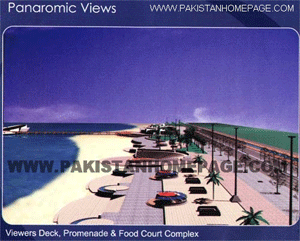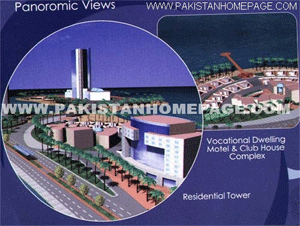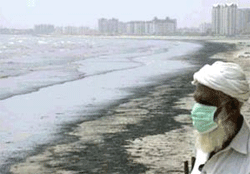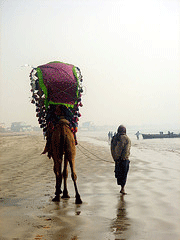In Karachi, Pakistan there are two development projects underway. The Port and Shipping Minister Babur Ghouri has approved the construction of a fountain (650-foot high fountain, the second highest in the world) which cost is Rs320 million for the poor people. A fountain that when it does work (by design — reportedly — it remains inoperative for half the year) sends water shooting uselessly up into the sky so that poor people —can gawk at it while holding on to their starving and parched children. People in Karachi don’t have safe drinking water and the city’s sanitation, sewage and drainage system is in the worst shape possible and millions of its residents are slum dwellers yet. This reality brings to mind Coleridge’s lines: “Water, water everywhere / Nor a drop to drink” (1). Poor people in Pakistan need electricity, clean water, jobs, education, and food on the table for their families.
Also, another multi-billion dollar DHA’s Waterfront Development Project is planned over a stretch of 14 kilometres of land from Sindbad (Old Casino) up to the Golf Course in Clifton Beach. The plan divides the coastline into seven distinct zones (A to G) and envisages high-rise commercial building complexes, hyper marts, food courts, cinema, amusement park, five-star hotel, an underwater world with a Dolphin Park and aquarium, amphitheatre complex with a capacity of 6,000 people and water sports facilities. The plan also includes a 600-feet Monumental Tower, with a revolving restaurant and observatory deck. Besides this, a Water Park with water sports, rides, swimming zones and a wave island is planned on 11 acres of land. The plan also allows for viewers’ deck, parks, a promenade and piazzas but these public access areas seem to make a very small part of the plan.


Once the DHA’s plans were completed, the “poor people” of the city may not even let anywhere near the fountain or the Clifton beach area. According to the DHA’s own press release of February 2005, it has initiated a US$623 million commercial project. For the excerpts from DHA Karachi’s website and brochure the creativity and imagination is promising to make Karachi beachfront a much sought-after tourist destination in the foreseeable future. Entirely practical and wholly realizable projects will have a deep impact on the lifestyle of the people of Karachi whose perception of enjoying the sea at present consists of riding a camel or a horse or just taking a walk on the wet sand and watching the waves crash on the shore. They will soon have access to multiple recreational activities within their reach.
What the authorities and experts do not consider is the poor people will be happy enough to go to the beach or to a nearby public park. Lord knows Karachi needs many more public parks and green areas for its 15 million residents, particularly the underprivileged ones. It is necessary to ensure the continued free access to public beaches — one of the very few options available for some cheap, wholesome entertainment for the less fortunate — for those who can’t afford to be gouged for the privileges.

DHA Waterfront Development Project
The project is supposed to be completed by 2015 and some construction has already been started. The project divide Clifton Beach into 7 zones, with different structures being earmarked for each. American and Dubai-based companies are involved in the whole enterprise.
What all this 5-star exclusivity — an offering to the gods of globalisation and commercialisation — translates to is the exclusion of poor people from a public area the use of which they are entitled to by law. Once completed, most of the project’s facilities will be free only to those who can afford to pay for it. Those who can’t (meaning Mr Ghouri’s favoured underprivileged souls), be damned. In fact, the poor are already being made to feel unwelcome. The small-time hawkers, street vendors and rehri-wallahs have been turned into persona non grata and are being deprived of their livelihoods so that multinational food chains can take their place.
There are also bigger issues to be considered here. Firstly, and most importantly, it needs to be determined whether the DHA has any authority over the Clifton beach. Beaches are legally meant for the public at large. Can the DHA undertake a project which excludes a majority of the city’s population? This also raises the issue of the legality and the process of allocation of public land to the armed forces.
In the meantime, the DHA needs to inform the public whether it has carried out an Environmental Impact Assessment (EIA) prior to the commencement of the project. This is a requirement of the law (under the Pakistan Environmental Protection Act, 1997) for projects of such magnitude. Moreover, the findings of the EIA have to be put before the general public and their opinions and concurrence sought before the project can proceed. This means that it is our right as citizens of this city and this country to participate in such a decision-making process.
They have to have an Environmental Impact Assessment, but they don’t have it. No such thing. They have not done it. Not only this, before they started this whole reclamation project which destroyed the wetlands, they needed to have an Environment Impact Assessment, but they did not do it then either. Also, they have taken the coast with the Marina Club and all these hotels they have built there, and are not allowing anyone any access to this beautiful stretch where we used to fish once. Why should we believe that they will provide access to people on this project?
Privatisation of the beach
In April last year, five concerned citizens of the Defence Housing Authority approached the Sindh High Court (CP 403/05) seeking to save one section of the beach — the 13-acre Usmani Park, between Beach Avenue and the sea — from being converted into another gigantic shopping-cum-entertainment-cum-residential complex. Last January, Shehri too intervened with a petition of its own. It was brought to the court’s attention that if the DHA is allowed to get away with this ‘privatization’ of the public beach, it will have the adverse effect of encouraging other parties to attempt to exploit and privatise what other few open spaces, amenities and facilities are left for the people.
As the petition states, the sea shore conversion project is in violation of the Pakistan Environmental Protection Act 1997. If this ‘development’ is allowed, the increased commercialisation will add to the existing pollution. It will destroy any surviving marine micro-organisms and will result in the extinction or mass reduction of fish, turtles, and coastal birds, and in the general depletion of the sea-food industry.
A Sindh government notification of May 1975 prohibits the leasing of land within the area of the ports or sea shore limits. The beaches around the DHA are within the limits of the Karachi Port Trust and the Port Qasim Authority.
The question is if the city can really cope with these gimmicky development schemes which only serve to line a few select pockets? Is there any infrastructure to bear further so-called ‘development’ projects? This city has 16 to 18 million inhabitants, nearly half of whom live in katchi abadis (2). It has serious problems with its water supply, sewerage systems, storm drainage, and electricity supply.
But, for the Defence Housing Authority the city beach would be turned into an attractive recreational resort for the public with the provision of proper lighting, decent sitting areas, board-walks, amphitheatres, jogging tracks, performance decks, water parks and children parks. Responding to concerns voiced about the project regarding its waterfront development project, a DHA spokesman refuted the allegation that the project would deny beach access to common citizens. He said not even one-kilometre land of the beachfront was being denied to the general public. Instead the quality of the beach was being enhanced manifold. The beachfront area in its improved yet pristine form is being made available to all and sundry, he added. The spokesman maintained that environmental protection; coastal conservation and town planning as per international standards were integral to the project.

But, on behalf of Arif Hasan, the development that is taking place cannot give access to this area to the vast majority of Karachi. Besides, fishing communities will also be affected, and the impact on environment is unknown. No Environment Impact Assessment has been undertaken yet. For Arif Hasan “…if you study the plan you will see that 80 per cent will in no way be accessible to the general public. This is high-income development meant for the rich. Even if the beach is not being privatised, the nature of the development will restrict access of the beach to those who can pay. (…) There is no denial of access between the road and the water. There is a construction of facilities on the beach but that happens with the natural environment intact. It is universally recognised in all development that except in isolated instances, you cannot deprive people of the beach and the sea. It is a well-understood doctrine, ‘the doctrine of public trust’ (…) The only place this has happened recently is in Sri Lanka, where a 3 km stretch has been taken over by private hotels, etc and there have been protests against it. And besides, Ari Hasan asks himself, why do we have to imitate the worst available examples of social and physical development? Don’t we have brains?
The DHA reiterated that DHA Waterfront Project was formalised after due consideration of multifaceted aspects, most importantly the value-addition of the beachfront. The creation of jobs for the poor is one of the arguments used by the DHA. Nevertheless, Ari Hasan considers that there is unemployment because jobs available today require a certain set of skills that are not available, because institutions that can train people in those skills are not present. So if these advocates are so serious about job creation then why don’t they setup these institutions at a fraction of this project’s cost?” Another discussion issue is that if they do not undertake this Waterfront Project, the beach will turn into a katchi abadi”. Ari Hasan has worked in lower income settlements for many years, and he affirm “that not one inch of land can be occupied without the approval of the authorities and officials involved. So either the Defence Society lots are remarkably incompetent or they are corrupt. Otherwise what they say is not possible”.
Proposal for a global strategy
The development projects in Karachi seem to have two dimensions: one relating to the access of the people, and the other being the environment. For Ari Hasan modern urban planning has demonstrated that there is a need for developing a process whereby the natural environment is not destroyed. It should be preserved for the residents of the city. Unfortunately, in Karachi’s case, the natural assets of the city have been completely usurped by the rich. The trend in Karachi has been that the more valuable the land more powerful the usurper.

The development projects consider only the foreigners and rich people, never the poor and they needs. To stop these initiatives it is evident that society must to organize itself, and make pressure over politicians and authorities. Nevertheless, the organization problem is also in intimate relation with social conditions. The DHA Waterfront Project is one face of real estate violence and authority’s complicity. The awareness about this subject is one step on the road to organize people. It is clear that the concept of ‘development’ is not the same for the different social groups, the spatial segregation of cities is a common reality in almost all countries. In Karachi’s case the new development project attempt against a single principle of access to public spaces for everyone.
A well thought-out proactive, not reactive, methodology is required to address the issues of the critical utilities in Karachi — not the expropriation of whatever spaces are left open and massive commercialisation and ‘development’ relying on the present totally inadequate infrastructure. Whoever it is who has this city at his mercy needs to get his priorities lined up in the right direction.
Key words
privatization, impact on environment, environmental degradation, tourism, tourism and environment
, Pakistan, Karachi
file
Source
Articles and files
MUMTAZ Khusro, Fountain for the poor, beaches for the rich, Daily The News, Monday, August 28, 2006
COWASJEE Ardeshir, No alternative but to soldier on, Daily Dawn, August 27, 2006
HASAN Ari, The natural assets of Karachi have been completely usurped by the rich, The News on Sunday
Urban Resource Centre - A-2, 2nd Floor, West Land Trade Centre, Commercial Central Area, Karachi Administrative Cooperative Housing Society, Block 7&8, Shaheed-e-Millat Road, Karachi 74800, PAKISTAN - Pakistan - www.urckarachi.org - urc (@) cyber.net.pk



